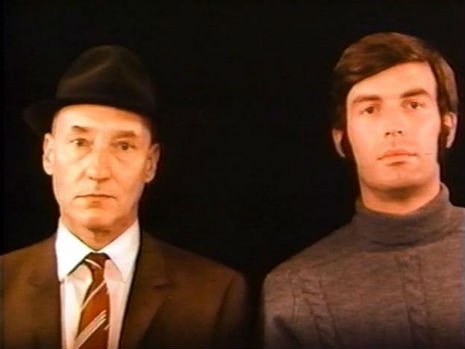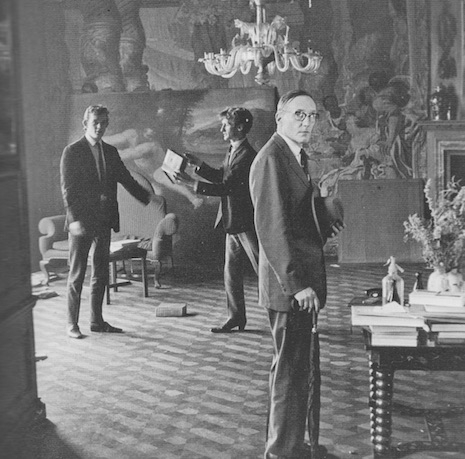
WSB by Charles Burns.
William Burroughs’ work has always been controversial. When Naked Lunch was first published it was denounced by critics as “obscene,” “repugnant” and “not unlike wading through the drains of a big city.” The poet and arbiter of highbrow taste, Edith Sitwell decried the book stating she did not want “to spend the rest of my life with my nose nailed to other people’s lavatories.” Its publication led to an infamous obscenity trial where Norman Mailer was called as a witness to defend the book and its writer. Mailer famously declared Burroughs as:
....the only American novelist living today who may conceivably be possessed by genius.
However, Burroughs was generally unfazed by his detractors—after all he wasn’t writing for them.
When Burroughs decided to make a short film The Cut-Ups with B-movie smut-peddler Antony Balch it was perhaps inevitable that their collaboration caused similar outrage.
When The Cut-Ups was first screened at the Cinephone, Oxford Street, London in 1966:
Members of the audience rushed out saying, ‘It’s disgusting,’ to which the staff would reply, ‘It’s got a U certificate, nothing disgusting about it, nothing the censor objected to.’
According to Burroughs biographer Barry Miles the Cinephone’s manager, Mr. Provisor:
...had never had so many people praise a film, or so many hate it.
During its two week run at the Cinephone, audiences were repulsed and repelled in almost equal measure. This can in part be explained by the fact the Cinephone was a mainstream movie house and not some avant garde cinema club.
Secondly the film’s use of overlaid images and a disturbing, repetitive soundtrack caused some of the audience to walk out of screenings perplexed, discombobulated, feeling nauseous, and leaving behind personal effects while demanding their money back.
Roy Underhill, assistant manager at the Cinephone told Balch during the film’s initial run:
...an unusual number of strange articles such as bags, pants, shoes, and coats were left behind, lost property, probably out of complete disorientation.
This was in many respects exactly the response writer Burroughs and producer Balch wanted to achieve: a complete “disorientation of the senses.”
The film ran for two weeks at the cinema during which time Balch edited it down to twelve minutes because the “staff were exposed to it five times a day, as well as having to deal with the walkouts and he thought that too much for them to handle.”

Burroughs and Balch.
Even today Antony Balch is “rarely acknowledged as the first of the British sixties experimental filmmakers.” In part because he exhibited only in mainstream movie theaters and also because he wanted to make big, wide screen films like the ones he loved to watch as a child.
Balch had a deep love of horror movies, in particular the film Boris Karloff and Bela Lugosi made at Universal in the 1930s and 1940s. His love of horror films was compounded when as a child he met the ageing Lugosi during a British stage tour of Dracula.
He was also good at making friends with the right people. In Paris during the 1950s, he met and hung out with artist Brion Gysin and druggie Glaswegian Beat writer Alexander Trocchi—who was paying for his habit by writing porn and editing a literary mag called Merlin. Through Gysin and Trocchi, Balch met two men who changed his life: William Burroughs and Kenneth Anger.
Anger helped Balch become a film distributor. He somehow managed to obtain access to the then banned movie Freaks. When the UK embargo was lifted in 1963, Balch was able to distribute Todd Browning’s notorious film across Britain. Balch paid Anger’s kindness back by screening his apocalyptic Invocation of My Demon Brother short (with its bleating Moog soundtrack by Mick Jagger) the support feature.
Burroughs offered Balch the opportunity to collaborate with a genuinely original talent and make their own films. Balch had been interested in Burroughs approach to writing and conceived of creating a movie that achieved on celluloid what Burroughs’ cut-up method did on paper.
Their first film project together was Towers Open Fire, an\ more-or-less accessible montage of Burroughs’ routines, recorded on a Grundig tape recorder, cut-up to Balch’s filmed and found images of a “crumbling society.” This was just a rehearsal for what was to come.
Their second collaboration The Cut-Ups (1965) went through various stages before reaching its full disorientating potential.
The Cut Ups was originally intended as a documentary called Guerilla Conditions which was filmed in Tangiers and Paris between 1961 and 1965. This project included some footage from Balch’s aborted attempt to make a movie of Burroughs’ Naked Lunch. This footage was edited together. Inspired by Brion Gysin and Burroughs’ cut-up techniques, Balch then had the labs cut the unseen footage into four sections of equal length. Once this was done the film was:
...assembled into its final state by taking one-foot lengths from each of the four sections that were cut together with mathematical precision — 1,2,3,4,1,2,3,4 etc. Variations to this structure occur randomly when a shot change occurs within one of the already edited one-foot lengths.
Balch faced very difficult grading problems. “Twenty minutes with one change every foot was just too much, what we did was to have a graded fine-grain print made of the edited sequences and then chop up the fine grain and make a dupe negative from it, so the film prints at one light.” The film was cut into exact lengths by none of the actual artists. “The actual chopping was done by a lady who was employed to take a foot from each roll and join them up. A purely mechanical thing, nobody was exercising any artistic judgement at all.”

Burroughs with Michael Portman and Ian Sommerville in background, 1966.
The audio track was created by Burroughs, Gysin and Ian Somerville and consisted of various permutations of just four phrases: “Yes, Hello?”, “Look at that picture,” “Does it seem to be persisting?” and “Good. Thank you.”
Balch went on to make produce classic schlock such as Secrets of Sex and Horror Hospital, while making a decent living as a distributor of soft core porn and exploitation flicks. He died of stomach cancer in 1980.